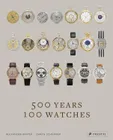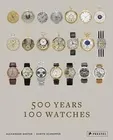- Книги
- Нехудожественная литература
- Искусство и культура
- Искусствоведение






500 Years, 100 Watches
О книге
Описание
На протяжении веков люди восхищались часами — будь то из-за их технической точности, уникального дизайна или исторической значимости. Каждая из ста моделей часов, представленных в этой элегантной книге, отличается одним или несколькими из этих качеств. Представленные в хронологическом порядке и с разбивкой по столетиям, часы представлены на просторных разворотах, состоящих из двух страниц, с изысканными фотографиями и увлекательными, содержательными текстами.
Читатели познакомятся с примерами самых ранних моделей часов: удивительными часами елизаветинской эпохи с циферблатом в виде астролябии; часами начала 17 века, инкрустированными одним изумрудом; двумя самыми ранними часами с балансирной пружиной - особенностью, которая произвела революцию в портативном хронометре; и одними из первых часов с повторяющимся и вечным календарями.. За ними следуют первые рычажные часы, изобретенные Томасом Маджем (Thomas Mudge); высокоточные наручные часы; часы с эмалью начала 19 века и часы-автоматы; очень сложные часы Breguet и Patek Philippe; Часы World Time Victory из желтого золота от сэра Уинстона Черчилля; наручные часы Rolex, изготовленные в честь Дня Республики Индия; часы Omega Speedmaster, которые отправились в космос; и наручные часы Roger Smith, выпущенные в 2023 году.
Эта историческая коллекция, состоящая из прекрасно воспроизведенных фотографий, которые впервые публикуются в виде книги, понравится искушенным коллекционерам, любителям часов и всем, кто интересуется искусством и наукой часового дела.
Комментарий
From two of the world’s leading experts on watch collecting, this supremely elegant and informative selection of one hundred watches traces the timepiece’s evolution as it highlights unusual, important, and beautifully crafted watches of the past half a millennium. For centuries people have been captivated by watches—whether for their technical precision, their unique design, or their historic importance. Each of the one hundred watches profiled in this elegant book stands out for one or more of these qualities. Organized chronologically and divided by century, the watches are presented in spacious, double-page spreads, featuring exquisite photography with engaging, incisive texts. Readers will discover examples of the earliest watch forms; an astonishing Elizabethan-era watch with astrolabic dial; an early 17th century watch encased in a single emerald; two of the earliest watches to incorporate the balance spring—a feature that revolutionized the portable timekeeper; and some of the first repeating and perpetual calendar watches. These are followed by the first lever watch, invented by Thomas Mudge; important precision watches; early 19th century enamel and automaton watches; highly complex watches by Breguet and Patek Philippe; Sir Winston Churchill’s yellow gold World Time Victory watch; a Rolex wristwatch made to commemorate Indian Republic Day; an Omega Speedmaster that went into space; and a Roger Smith wristwatch completed in 2023. Featuring exquisitely reproduced photographs that are appearing for the first time together in book form, this historic collection will appeal to sophisticated collectors, amateur watch enthusiasts, and anyone with an interest in the art and science of horology.
Автор на обложке
Alexander Barter, Daryn Schnipper
- Артикул
- 1558868271
- Автор
- Не указан
- Издательство
- Prestel
- Год выпуска
- 2024
- Тип бумаги в книге
- Мелованная
- Тип обложки
- Твердый переплет
- Тип книги
- Печатная книга
- Язык издания
- Английский
- Количество страниц
- 304
- Формат издания
- 310x250
- Размеры, мм
- 310x250x30
- Вес товара, г
- 2100
- Тираж
- 1000
- ISBN
- 9783791379753
- Оригинальное название
- 500 Years, 100 Watches
Подборки товаров в категории Книги и альбомы по искусству
Вопросы и ответы 0
Как правильно задавать вопросы?
Будьте вежливы и спрашивайте о товаре, на карточке которого вы находитесь
Если вы обнаружили ошибку в описанием товара, воспользуйтесь функцией
Как отвечать на вопросы?
Отвечать на вопросы могут клиенты, купившие товар, и официальные представители.
Выбрать «Лучший ответ» может только автор вопроса, если именно этот ответ ему помог.






